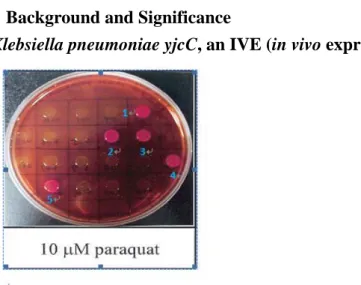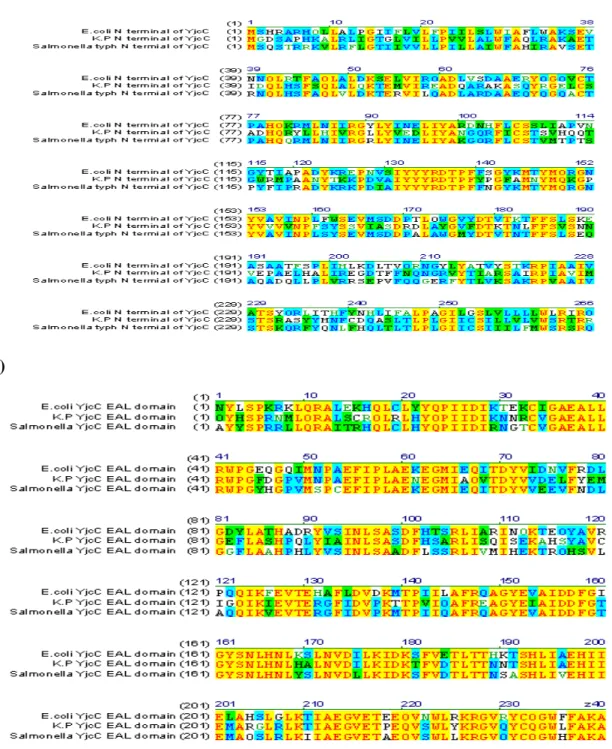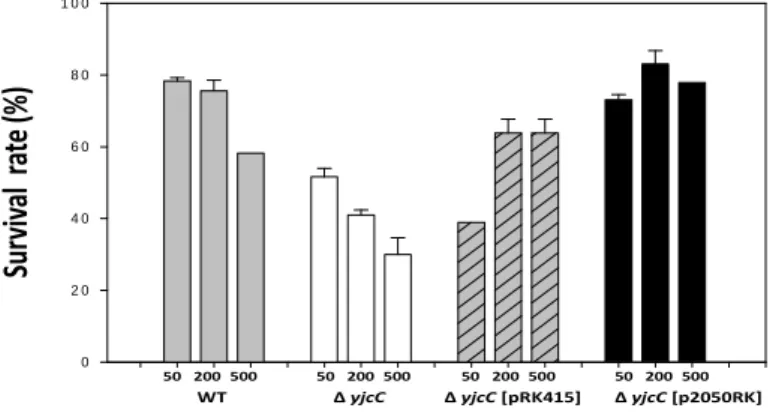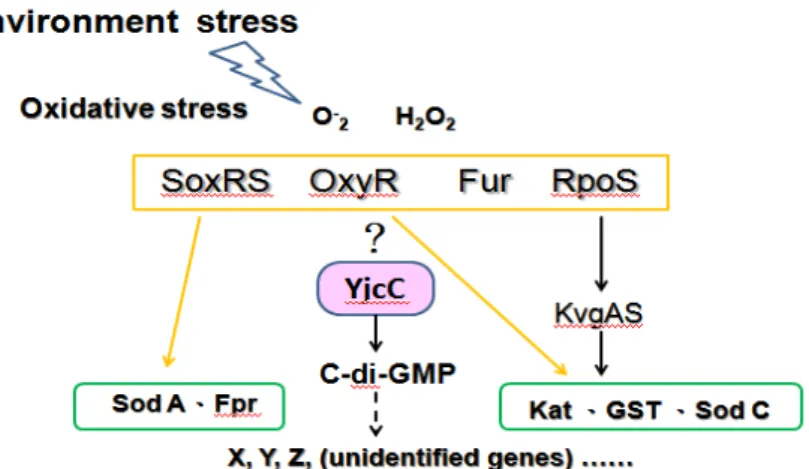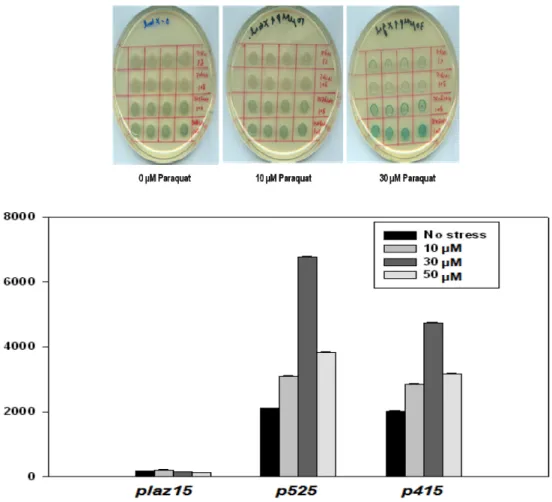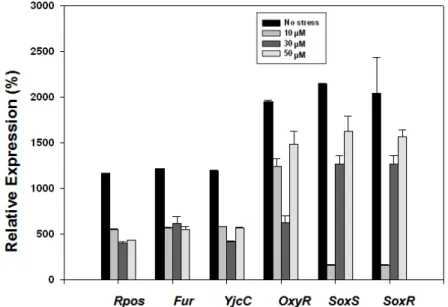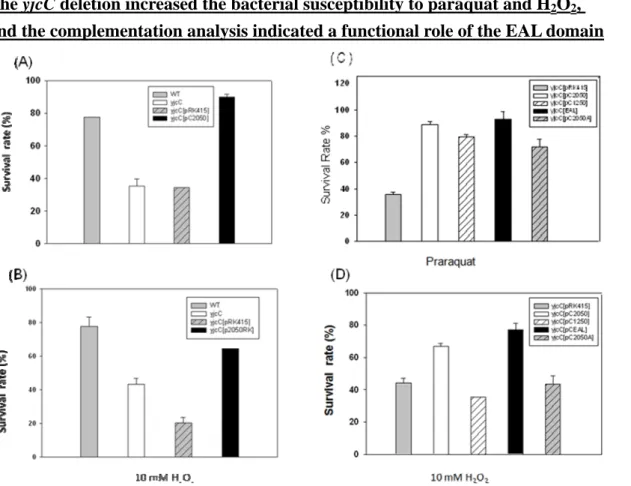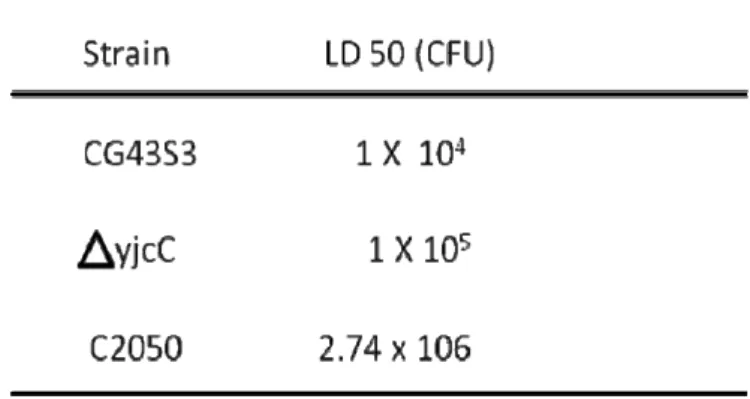行政院國家科學委員會補助專題研究計畫
□ 成 果 報 告 ▓期中進度報告Role of the in vivo expression protein YjcC in the oxidative stress
responses in Klebsiella pneumoniae CG43
計畫類別:
■
個別型計畫 □ 整合型計畫
計畫編號:NSC 97-2320-B-009-001-MY3
執行期間:97年8月1日至98年7月31日
計畫主持人:彭慧玲
共同主持人:
計畫參與人員:黃靜柔
成果報告類型(依經費核定清單規定繳交):
■
精簡報告 □完整報告
本成果報告包括以下應繳交之附件:
□赴國外出差或研習心得報告一份
□赴大陸地區出差或研習心得報告一份
■出席國際學術會議心得報告一份
□國際合作研究計畫國外研究報告書一份
處理方式:除產學合作研究計畫、提升產業技術及人才培育研究計
畫、列管計畫及下列情形者外,得立即公開查詢
□涉及專利或其他智慧財產權,□一年□二年後可公開查詢
執行單位:國立交通大學生物科技學院生物科技研究所
I. Abstract
Ia. Abstract in Chinese
關鍵詞:克雷白氏肺炎菌CG43,活體表現蛋白 YjcC,EAL domain 功能,
過氧化逆境反應,小鼠毒性。
感染過程中,如何抵抗過氧化的逆境壓力,是決定細菌毒性的重要因子。
我們曾報導克雷白氏肺炎桿菌CG43 在老鼠活體表現的 YjcC 蛋白可被 10 μM
巴拉刮所誘導,同時,基因結構分析顯示過氧化逆境的兩個主要調控基因
soxS 和 soxR 座落於 yjcC 基因旁,我們的先導實驗更證明 yjcC 基因缺損會
使細菌抗氧化逆境的能力大為降低,這些結果顯示YjcC 蛋白在克雷白氏肺 炎桿菌 CG43 抗氧化逆境反應中扮演重要的角色。我們在過去一年中除了 建立 yjcC 啟動子報導系統證明此基因確實受巴拉刮所誘導而活化,而在定 量PCR 的實驗當中,初步結果顯示加入不同濃度的巴拉刮後,yjcC 轉錄作 用表現的趨勢與 RpoS 和 Fur 的趨勢相同;另外,分別建構了不同片段的 yjcC-expression plasmids 以 200 μM 的巴拉刮或 10 mM 的過氧化氫進行存
活率測試,發現將 yjcC 基因的 C 端帶有 EAL domain 的區域剔除掉以及將 麩安酸(E:glutamic acid)突變之後則對於抗氧化逆境的能力比原先互補 yjcC
的質體下降,暗示著EAL domain 在功能上能幫助 YjcC 對抗氧化逆境。最
後,利用小鼠腹膜炎實驗發現:相較於野株,yjcC 基因剔除的突變株毒性
減弱約10 倍,因此推測 YjcC 蛋白功能與其感染致病相關。
I. Abstract
Ib. Abstract in English
Key words: Klebsiella pneumoniae CG43; IVE yjcC; functional EAL domain, oxidative stress responses and virulence determination using mouse peritonitis model.
During infection, defenses against oxidative stress play an important role in determining the bacterial virulence. The expression of yjcC, previously identified by in vivo expression technology (IVET) in Klebsiella pneumoniae CG43, was found to
be inducible by 10 M paraquat. Analysis of the gene organization revealed two
oxidative stress regulators SoxR and SoxS encoding genes were next to yjcC gene. The deletion of yjcC was found to decrease the bacterial survival under the treatment of paraquat further suggesting the involvement of YjcC in the oxidative stress defense. We have carried out the studies in the past year to demonstrate that the expression of yjcC is paraquat inducible assessed using a LacZ reporter system. The subsequent
real-time PCR analysis under the treatment with paraquat or H2O2 revealed similar
expression patterns of yjcC with those of rpoS and fur gene. Transformation of the yjcC deletion mutant with the plasmid pC2050 that carries yjcC encoding gene restored the bacterial growth upon the treatment with 200 μM of paraquat or 10 mM
H2O2, further supporting a role of YjcC in the oxidative stress response. In addition,
the plasmid pC1250, carrying a truncated yjcC removed of EAL domain encoding
region, or pC2050A, carrying a site-directed-mutation yjcC gene coding for YjcCE303A,
has also been introduced into the mutant. Nevertheless, neither plasmid could complement the yjcC deletion effect suggesting that the EAL domain is required for a functional YjcC. Finally, the yjcC deletion mutant exerted a 10-fold decrease of LD50 in mouse peritonitis model further potentiates a role of YjcC in the bacterial infection.
II. Background and Significance
Klebsiella pneumoniae yjcC, an IVE (in vivo expression) gene
Fig. 1. Phenotypes of IVE clones on MacConkey-galactose agar containing 10 μM
paraquat (1). 1: lysA , 2: yfjB, 3: yjcC , 4 and 5:unknown function.
As shown in Fig. 1, the five paraquat-inducible ive genes include lysA, yfjB, yjcC,
and two unknown function sequences. LysA encodes the last enzyme in lysine biosynthetic pathway which has been considered as potential targets for antibacterial drugs and herbicides (2). Mycobacterium tuberculosis lysA deletion mutant has been demonstrated to be attenuated and safe as vaccine candidate in mice (3).
YfjB is an NAD kinase which has been regarded as the key enzyme for the regulation of the NADP level and NADP-dependent pathways in cells (4). While analysis of the yet known function YjcC revealed similar gene organization and significant sequence homology with that of the E. coli and S. typhimurium homologs.
Fig. 2. The yjcC containing gene clusters of E. coli K12, K. pneumoniae
NTUHK2044, and Salmonella enterica serovar Typhimurium. As shown in Fig. 2, the global oxidative stress regulators SoxR and SoxS encoding genes are upstream located suggesting a role of YjcC in the response to oxidative stress and hence yjcC was chosen for further study.
As shown in Fig. 3(A), the comparative analysis of the N-terminal sequences revealed 41% identity between Kp-YjcC and Ec-YjcC, and 50% identity between Kp-YjcC and St-YjcC. The Blast search for the sensory domain at the N-terminus of YjcC revealed no classified functional motif. However, a couple of conserved blocks including aa 40~100 and 130~188 (Fig. 3A) could be identified. In contrast, the C-terminal sequences containing EAL domain appeared to be highly conserved in three bacteria (Fig. 3B).
(A)
(B)
Fig. 3. Alignments of YjcC (A) N-terminal sequences and (B) EAL domain
Pilot study To investigate if YjcC plays a role in oxidative stress response, the
yjcC deletion mutant was obtained by allelic exchange method and the susceptibility
toparaquat was determined.
0 2 0 4 0 6 0 8 0 1 0 0 50 200 500 50 200 500 50 200 500 50 200 500
WT Δ yjcC Δ yjcC [pRK415] Δ yjcC [p2050RK]
Sur viv al ra te (% )
Fig. 4. Paraquat sensitivity assay. The overnight cultures were refreshed grown in
LB until OD600 of 0.6~0.7. Aliquots of 50, 200,500 μM of paraquat were then added and the incubation continued for 35 min at 37℃. Finally, the cultures were plated onto LB plates for colony formation and the relative survival was determined as ratio of the viable count to the colony number of untreated-inoculum.
As shown in Fig. 4, Under the treatment of 50 μM paraquat, a dramatic decrease of the bacterial resistance to paraquat was observed and the introduction of the yjcC-expression plasmid enhanced the bacterial resistance to higher level of paraquat
(200 and 500 μM), supporting a role of YjcC in the bacterial resistance to oxidative
stress. Specific aims of the proposed studies as shown in Fig. 5 are (1) To investigate the functional role of YjcC in the oxidative stress defense; (2) To identify the regulatory system(s) for optimal expression of yjcC; (3) To show how and why YjcC is expressed in vivo to encounter the oxidative stress.
Fig. 5. A proposed study for the functional role of YjcC in K. pneumoniae CG43.
III. Materials and methods
Paraquat and H2O2 survival assessment One-hundredth overninght grown bacteria
were inoculated to LB and incubated at 37 to℃ OD600 of 0.6~0.7. Aliquot of the
bacteria were then collected by centrifugation and resuspended in 200 μM of Paraquat and 10 mM H2O2 respectively, then subjected to 37℃ incubation for 35 min. CFU of the bacteria after the stress treatment were counted, and the survival rate was determined by the ratio of the CFU. The representative data at least three independent experiments were presented. Every sample was assayed in triplicate, and the average activity and standard deviation were presented.
Construction of YjcCE303A expression plasmid by site-directed mutagenesis
Site-directed mutagenesis was carried out essentially as described by QuikChange Site-Directed Mutagenesis Kit (Stratagene, USA). Glu303 in the EAL domain of YjcC is responsible for phosphodiestrase enzyme activity, which was changed in to alanine
in pC2050, and the resulting plasmids was named pC2050A (YjcCE303A).
Promoter activity assessment β-galactosidase activity was determined essentially as
described by Miller. The data presented were derived from a single experiment which was representative of at least three independent experiments. Every sample was assayed in triplicate, and the average activity and standard deviation were presented.
Mouse lethality assay Female BALB/c mice with an average weight of 25 g will be
obtained. The tested bacteria suspended in 10-fold steps graded dose in 0.2 ml saline will be injected intraperitoneally. The LD50 will be determined by the method of Reed and Muench (5) and expressed as CFU.
Real-Time PCR analysis Three micrograms of the DNase I-treated total RNA
extracted from K. pneumoniae CG43 or the derived strains treated with or without paraquat was reverse transcribed to generate cDNA using AMV Reverse Transcriptase and random primer pDN(6) according to the manufacturer's instructions (Roche). Real-time PCR (RT-PCR) analyzing the transcription of rpoS, oxyR, fur, yjcC, soxR, soxS and 23S rRNA using each cDNA as a template was performed using SYBR Green PCR Master Mix and SDS 2.1 software on a PRISM 7000 HT platform (Applied Biosystems). Relative quantification of rpoS, oxyR, fur, yjcC, soxR and soxS transcription in various conditions and various strains was analyzed by the comparative Ct (threshold cycle) method. The internal control used here was 23S rRNA.
IV. Progress Report and Discussion
Promoter activity analysis using LacZ as a reporter indicated PyjcC is a
paraquat-inducible promoter
Fig. 6. Measurement of the yjcC promoter activity. The putative promoters which
respectively contain 415 bp and 525 bp of the non-coding region upstream of yjcC were isolated and cloned into the promoterless lacZ reporter plasmid placZ15. The recombinant plasmids were then transformed to K. pneumoniae CG43Z01 and the β-galactosidase activity of the transformants measured.
Real-time PCR analysis under the treatment with paraquat (PQ) or H2O2 revealed similar expression patterns of yjcC with those of rpoS and fur gene
Fig. 7. Real –Time PCR analysis. The overnight cultures were collected, refreshed
grown in LB until OD600 of 0.6~0.7 and incubated with 10, 30, or 50 μM PQ or without PQ for 35 min. The target genes for RT-PCR analysis included rpoS, fur, yjcC, oxyR, soxS and soxR. 100% expression is defined as the expression of wild-type strain
Construction of the recombinant plasmids for the complementation analysis
The recombinant plasmids are pC2050, the plasmid carries a yjcC encoding gene; pC1250, the plasmid carries a truncated yjcC removal of the EAL domain
The yjcC deletion increased the bacterial susceptibility to paraquat and H2O2, and the complementation analysis indicated a functional role of the EAL domain
Fig. 8. Paraquat and H2O2 sensitivity assay. The overnight cultures were collected,
refreshed in LB, and the cultures continued until OD600 of 0.6~0.7 Subsequently,
aliquots of 200 μM of paraquat (A and C) or 10 mM H2O2 (B and D)were
respectively added and the cultures continued for 45 min at 37℃. Finally, the cultures were plated onto LB plates for colony formation.
Mouse lethality assay revealed a virulence role of YjcC
Table 1. Mouse lethality assay . The tested bacterial strains were
cultured in LB medium at 37°C overnight. Four mice of a group were injected intraperitoneally with bacteria suspended in 0.2 ml of PBS in 10-fold-graded doses. The LD50, based on the number of survivors after one week, was calculated by the method of Reed and Muench and expressed as CFU.
V. Discussion
Sequence analysis of the putative promoter of yjcC revealed no conserved RpoS- or Fur-binding elements. However, the promoter activity measurement and the real-time PCR analysis suggested that YjcC is a component of the RpoS or Fur regulon. If yjcC is under the control of RpoS or Fur is currently under investigation. The yjcC deletion mutant revealed an increased susceptibility to paraquat and
hydrogen peroxide, and the deficiency could be complemented by transferring into the mutant with a YjcC-expression plasmid. This indicated an involvement of YjcC in the anti-oxidative stress response. The paraquat resistance activity was not able to be restored while in trans supplying the mutant with pC1250 or pC2050A implying the EAL domain plays a role in the oxidative stress response. Moreover, the deletion of yjcC resulted in an increase of LD50 suggesting a role of YjcC in regulation of the bacterial virulence. To demonstrate that yjcC plays a role in anti-phagocytosis during the infection, CG43-derived wza-yjcC double mutant has been generated.
VI. Literature Cited
1. Lai YC, Peng HL, Chang HY. 2001. Identification of genes induced in vivo during Klebsiella pneimoniae CG43 infection. Infect Immun 69:7140-5.
2. Li X, Ricke SC. 2003. Characterization of an Escherichia coli lysA insertion targeted mutant using phenotype assays. Bioresource Technology 89:249-253. 3. Sambandamurthy VK, Derrick SC, Jalapathy KV, Chen B, 2005. Long-term
protection against tuberculosis following vaccination with a severely attenuated double lysine and panthothenate auxotroph of Mycobacterium tuberculosis. Infect Immun 73:1196-1203.
4. Kawai S, Mori S, Mukai T, Hashimoto W, Murata K. 2001. Molecular characterization of Escherichia coli NAD kinase. Eur J Biochem 268:4359-65. 5. Reed LJ, Muench H. 1938. A simple method of estimating fifty percent endpoints.
